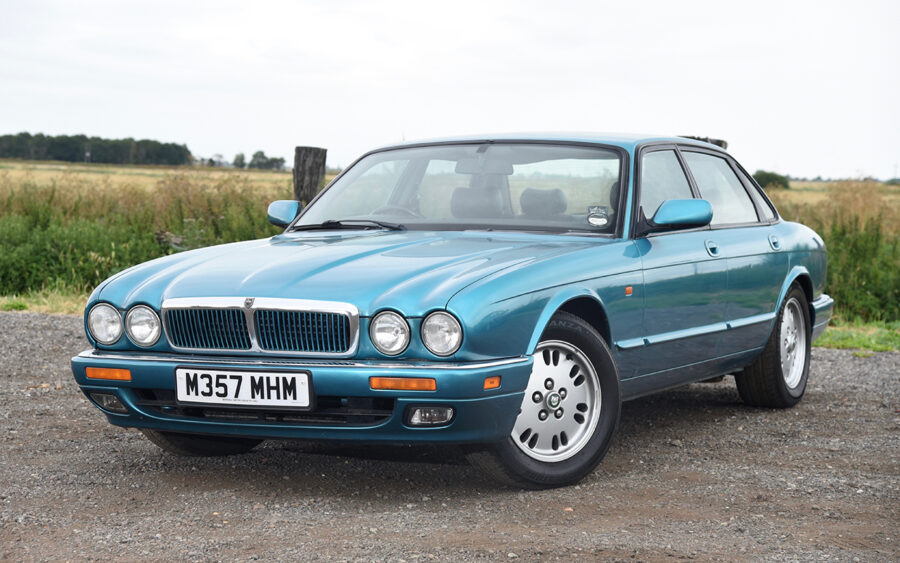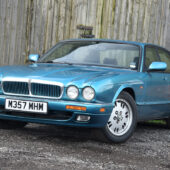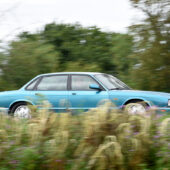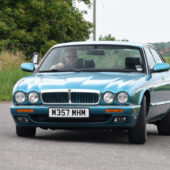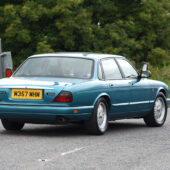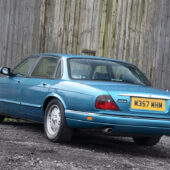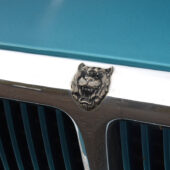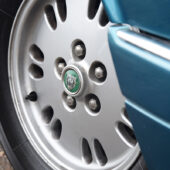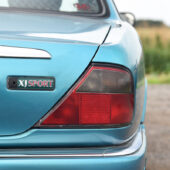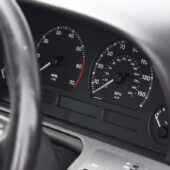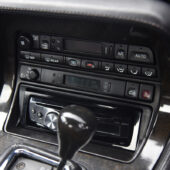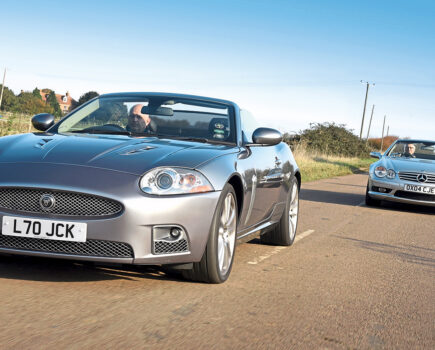With its sleek, traditional styling, strong engines and strong specialist support, the X300-generation Jaguar XJ remains a great luxury saloon. Here’s how to buy a good one
Words: Rob Hawkins Images: Paul Walton
Doing away with the boxy 1980s style of the outgoing XJ40 and replacing it with a retro-inspired treatment proved to be an inspired move by Jaguar’s owners Ford – and set the tone for a whole generation of Jaguars that sold heavily on the brand’s enviable heritage.
The steel-bodied X300 Jaguar XJ produced between 1994 and 1997 was a short-lived model with a total production of 92,038. The X300-generation XJ shared much of its underpinnings with the outgoing XJ40 and was initially available as a short-wheelbase model just over five metres long, with a long-wheelbase option available from June 1995 with an extra 12cm between the front and rear wheels.
Engine options include the 3.2-litre and 4.0-litre straight-six AJ16 units, a supercharged version of the 4.0-litre in the XJR model and a 6.0-litre V12 codenamed X305 in the range-topper. A ZF automatic four-speed gearbox was fitted to the 3.2 and 4.0 models (4HP22 and 4HP24 respectively); a Getrag five-speed manual was optional on these and the supercharged XJR 4.0, which also used a GM 4L80-E automatic gearbox as standard.
All X300 XJ models are luxurious in a traditional wood-and-leather manner, with Daimler equivalents bringing a higher level of standard equipment.
Bodywork
Road dirt and moisture from the front tyres pepper the insides of the X300’s wheelarches, and some of that debris gets past the wheelarch liner and into the metalwork of the front wings. Removing the wheelarch liners to clean and inspect the insides of the wings will help to preserve them (and rust-proofing them will also help) but if corrosion emerges holes can soon appear. New wings are expensive at over £700 each, whereas a used wing costs around £150–200. A repair panel at the rear costs around £330 whereas a complete rear quarter costs £500 or so.
The alloy sections of the mounts for the front and rear bumpers can swell with corrosion and break up, resulting in a loose bumper (try to shake the bumper to check its mounts are secure). The bumper is secured to two of these mounts with 19mm bolts which can seize, so apply lots of penetrating fluid before attempting to undo them. If you manage to successfully remove the bumper, then the mounts are secured with three 13mm bolts.
Tom Lenthall warns that the chrome trim on the bumpers can get damaged and become partially detached. Plus, the securing screws can become corroded and may need drilling out to remove them. New chrome trim for the bumpers is hard to find, although used items are available through Jaguar breakers.
Check the condition of the sills and jacking points from underneath the vehicle and inside the cabin (sills only) by tapping the handle of a screwdriver along them. These areas are prone to corrosion, so should be rust-proofed every couple of years. A sill repair panel costs around £300 and a jacking point is roughly £70, but the work involved in cutting out the old metal, fitting the new metal and painting will usually cost a lot more.
Water ingress into the footwells can be caused by corrosion around the windscreen, blocked sunroof drain holes or even corroded floors. Routinely check the carpets for damp and also check the ECU, which is mounted behind a kick panel, next to the accelerator pedal. If water gets into here it can result in ECU failure and wiring issues.
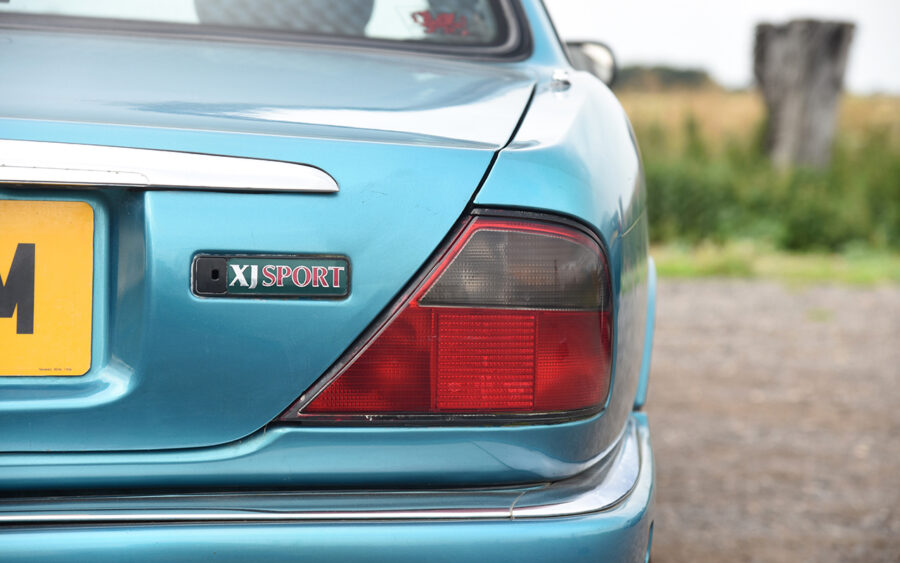
“The most serious problem we have found is water ingress on the main ECU,” comments Andy at Auto Reserve. “Water from the A-post and scuttle regularly comes into the car and runs straight over the upward-pointing plugs on the ECU. Look for signs of blue/green corrosion on the large red and black plugs and wiring.” Neville Anderson at Jaguar Spares North East also comments on water ingress for the ECU, explaining that it gets through the windscreen, runs along the wiring loom underneath and goes into the ECU.
Open the doors and look for a small drain hole along the bottom edge – poke a screwdriver through it to check it’s clear. This will allow water to drain from the door. Similarly, check the drain holes for the sills – if they are blocked, they may fill up with water and inevitably corrode. Lift the fuel filler flap, remove the filter to clean it and check that the drain hole near the filler cap is clear (pour warm water down it and check it drains below the vehicle).
“Cars stood for a long time outdoors always get water building up in the fuel flap bowl as a result of the fuel bowl drain getting filled with debris and becoming blocked,” comments Andy at Auto Reserve. “When the drain is blocked the water rises above the neck of the tank and seeps into the fuel tank. This causes rust in the tank and can seize the fuel pump; with water being heavier than fuel, it stays at the bottom of the tank, so the fuel pump can send water into the engine. I have never seen one hydraulically lock, but bad fuel as a result of water getting in the tank is quite common, so look for signs of crusty rust and rust staining on the inside of the fuel bowl.”
If your potential X300 XJ has a sunroof, open it and check there’s no dirt inside the channel in the roof. This also has drain holes which must remain clear to avoid the risk of corrosion and water ingress into the cabin.
“Sunroofs are a rare option and need inspection,” says Andy at Auto Reserve. “The motors themselves are reliable, but factory sunroof seals are no longer available, mechanisms often break and the sunroof is prone to rust under the seal.”
Andy also advises to check the operation of the sunroof because its module can become faulty, resulting in potential water ingress. “The sunroof tilts as well as slides using the one switch. The movement operation should stop at the point of being closed between slide and tilt, so you have to press the button again to go between tilt and slide and vice versa. It’s not a massive problem, but it is easy to think the sunroof is closed when there could be a gap. The fault lies with the module – a little box that fits next to the motor.”
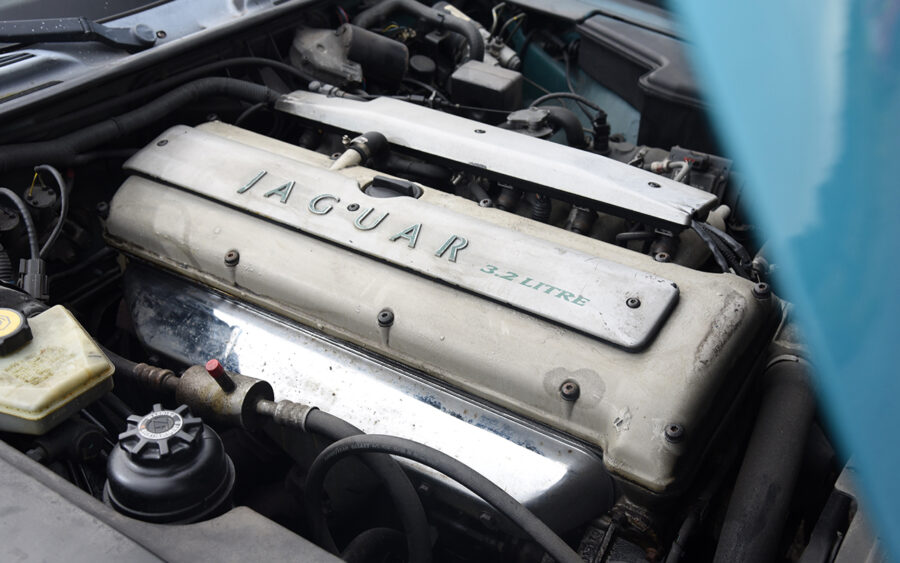
Engine and transmission
As with all old car purchases, it makes sense to pay particular attention under the bonnet of the X300 XJ. Oil leaks can emerge from around the rocker cover, which can often be fixed with a new gasket. Idle speed issues are sometimes caused by a gunged-up throttle flap inside the throttle body, which can often be cleaned, followed by a software procedure called a throttle pot adaptation which resets the maximum and minimum limits of the idle valve.
Jaguar specialist Tom Lenthall has found the head gasket on an X300 can cause oil to leak externally, while oil leaks are known to emerge from the front of the engine where the timing chain tensioner is fitted. If the head gasket fails it’ll be an expensive fix.
An oil, filter and spark plug change on an X300 Jaguar XJ can all be completed with a typical assortment of tools. On the V12 model, the spark plugs at the front of the engine are difficult to access due to the air-conditioning compressor and may have been neglected, so they could be seized, risking stripping the threads in the aluminium cylinder heads – set aside a couple of hours to carefully extract them.
Fitting the correct spark plugs (Champion RC9YCC plugs for the six-cylinder engines) is essential, according to Lenthall, as the resistance of these spark plugs works better with each coil pack. Also be sure to check the induction hoses for cracks, which could result in air leaks and running issues.
Most X300 models are equipped with an automatic gearbox, so the familiar J-Gate gearlever is found in most interiors. One of the biggest problems concerns a microswitch that detects when Park is selected, which allows the engine to be started, thus avoiding the problem of starting the engine in Drive and finding the car surges forwards. If the engine cannot be started, waggling the gear selector can sometimes temporarily resolve the problem, but the faulty microswitch won’t fix itself. There’s also a Park release solenoid, which allows the gear selector to be moved out of Park. This requires the brake pedal to be pressed. If the solenoid fails, the gearbox usually locks itself in Park.

A used J-Gate assembly costs around £25, whereas a Park release solenoid typically costs under £10. The microswitch is riveted in position, so it’s supplied with a J-Gate assembly, but replacing the J-Gate involves a partial stripdown of the interior.
A non-starting engine that turns over freely but doesn’t fire can be caused by failure of the crankshaft position sensor; a replacement costs around £40. However, Tom Lenthall has also found a fuel injection issue concerned with corrosion of the wiring loom due to water ingress. In some cases there’s a 12V feed to the fuel injectors, but when the engine is fired-up, this drops to around 5V so the engine will not run. The voltage drop is caused by the corroded wiring.
Idling problems can be caused by the idle valve (also known as the stepper motor), with replacements costing around £50. Lenthall says that if the idle speed is too high, cleaning inside the throttle body can help to fix this problem – but there is a technical bulletin from Jaguar explaining how to fit a stronger throttle return spring and set up the engine to calibrate the stepper motor.
Lambda (oxygen) sensor failure is common, resulting in high exhaust emissions; it can be tested using a multimeter. A new sensor costs around £60.
“The most common cause of a misfire is a faulty coil pack,” explains Andy at Auto Reserve. “The coil packs can just about be checked in the old-fashioned way by unplugging one at a time and listening for a change in engine note. Over time, the plastic insulating barrel part of the coil pack starts to split open, causing the charge to arc with the engine camshaft cover and giving a poor spark within the cylinder.” Individual coil packs are fitted to the 3.2 and 4.0 and can be bought separately for around £25 each, although a full set costs around £150.
Auto Reserve says that airflow meters can become faulty, resulting in engine running issues including over-fuelling and poor acceleration. Genuine ones are not available but aftermarket units can be found. An existing airflow meter can be tested with a multimeter to check the voltage readings between the signal and feed are correct at particular engine speeds. Neville at Jaguar Spares North East has found that if the coolant temperature sensor fails, it can lead to over-fuelling because the ECU and fuel system thinks the coolant is too cold.
Tom Lenthall explains the X300’s engine and electrics can mysteriously cut out, often after driving over a speed bump. This is because an inertia switch inside the nearside A-post has been activated (it detects the vehicle has been involved in a collision). Luckily, the switch can be reset from inside the passenger footwell; there’s a hole in the trim panel to access it.
Lenthall has found the exhaust manifolds can crack and leak but are often concealed by heatshields, so it’s worthwhile removing them to inspect them. If there are black sooty marks on the underside of the heatshield, then the manifold may be leaking. Running the engine without the heatshield fitted will help to check if there’s a problem (spray soapy water over them to check for air blowing out). In some cases, the exhaust manifold can be replaced.
For the X300 and its AJ16 six-cylinder engine, Nene Jag Specialists recommends an engine oil service annually or every 10,000 miles using eight litres of Shell 10W-40 semi-synthetic engine oil. The air filter should be changed every 20,000 miles, while the fuel filter should be changed every 60,000 miles.
The gearbox oil and filter should be changed every 30,000 miles using four litres of Dexron III gear oil, whereas the spark plugs should be renewed after 20,000 miles, ideally using Champion RC9YCC plugs, which Nene has found to work well. A brake fluid change every two years is sensible, as is a coolant change every four years.

Suspension, steering and brakes
Routine servicing of the all-round disc brakes will help to keep them in good working order. It’s important to clean and lubricate the slider pins and clean the brake pads and where they sit. If a piston inside a caliper becomes seized or starts to stick (Lenthall says the dust cover usually deteriorates, allowing water ingress to corrode the piston) it can be overhauled with new seals for around £30–40, or a refurbished exchange calliper costs around £75.
The brake fluid should be replaced every couple of years to avoid the risk of water absorption, which can result in internal corrosion and damage to seals.
The handbrake is mechanical and works on a set of small shoes inside the rear brake discs. Routine maintenance helps to keep these in good working order, especially on models with an automatic gearbox where Park is often wrongly used instead of the handbrake. The brake shoes can be adjusted via an inspection hole on the face of the brake disc – shine a torch inside to find the adjuster and move it using a screwdriver.
If the ABS light remains illuminated on the dashboard, there are a number of causes, which can be identified using diagnostic equipment. Typical reasons include a failed wheel speed sensor, which varies in price from between £30 and over £300 (depending on model, position and whether you want a genuine sensor or aftermarket). Andy Harper at Auto Reserve warns that rear sensors are the most expensive and some are almost impossible to source. He also says that the ABS pump (valve block) can suffer from pump motor circuit failure. They cost around £100 for a used non-traction control unit from them, which is the most common, or around £150 for one for traction control that’s usually fitted to the XJR and some Sport models.
Front lower suspension arm bushes seem to last for around 40,000–50,000 miles before they become worn and result in wheel alignment and handling issues. Replacements are readily available.
The lower mounting bushes for the rear dampers can wear, resulting in a knocking noise, although similar knocking noises can be caused by worn anti-roll bar drop-links and mounting bushes. New bushes cost around £15–20 each. Look for corrosion around the lower mount for the front coil springs and dampers; it can emerge behind the dampers and around to the inner chassis leg area, which is an MoT failure.
The rear subframe can be removed as a complete rolling assembly to overhaul many of its components. However, one component that can be removed in situ is known as the A-frame, which is prone to corrosion – it can be inspected from underneath the rear of the vehicle to check whether the corrosion has gone too far. We showed how to remove one of these in the January 2020 issue with Auto Reserve, who sell refurbished replacements for £495, which are media-blasted, painted in a zinc base coat before being powder-coated and equipped with new bushes.
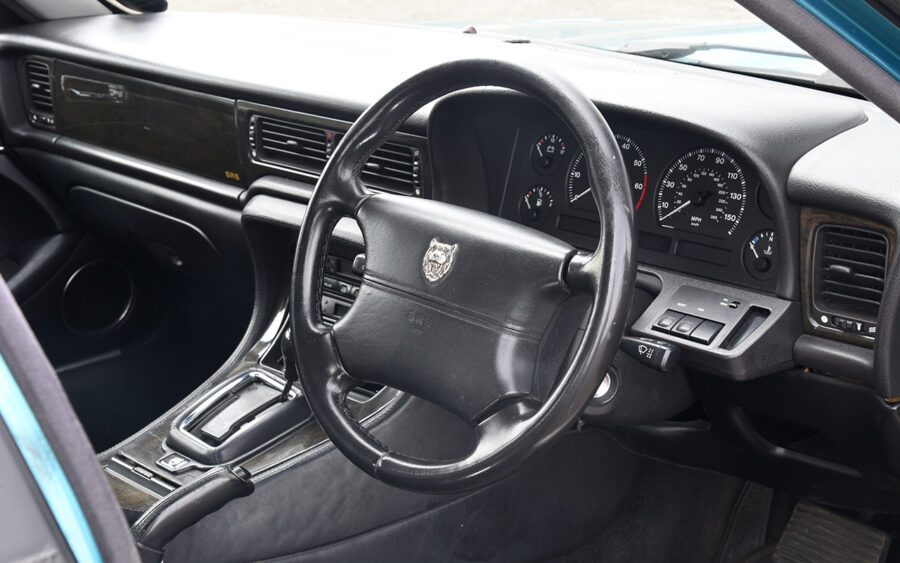
Interior and trim
The glue that holds the headlining to the roof board can fail, resulting in the material looking saggy in places. A temporary solution is to pin it to the board. Removal of the headlining board should ideally be done with the windscreen or rear screen removed, although its possible to remove the interior seating and feeding the board through the nearside doors (with risk of bending the board). Budget for around £240 for a replacement trimmed X300 headlining board.
The digital clock that’s fitted inside a switch panel for the heated front seats, hazard warning lights and for adjusting the headlight aim can fail, but Berkshire Jag Components can repair it for around £75. Make sure all the doors can be locked and unlocked from the inside and outside and via the remote locking key fob. Door locks can fail and cost over £400 each new, or around £30 used.
If the electrically adjustable front seats fail to operate or become problematic, the problem is often caused by the seat module instead of the switches on the side of each seat. A used seat module costs around £40.
Auto Reserve has found two main problems with the X300’s climate control. The first relates to the water heater pump, which is a booster pump to help deliver hot coolant from the engine into the heater matrix. If this pump fails, it blocks the movement of hot coolant, so hot air cannot be generated. The second problem concerns the air-conditioning, which is prone to minor leaks from the compressor, so it’s worthwhile having the system tested annually and refilled. A new compressor costs around £600, whereas a used one is roughly £80. Be sure to test out the air con on any potential purchase.
The leather upholstery in the X300 can become dirty, scuffed and torn over time. Leather cleaners should be able to keep it looking supple if it’s in good condition, but damaged upholstery may be easier to replace with a used seat cover. Other problems that can arise include scuff marks on the plastic seat back (front seats only) and damage to the map pocket.
Auto Reserve warns that the driver’s seatbelt can become worn inside the socket, resulting in the seatbelt plug not locking inside it. This must be fixed immediately because it’s illegal to drive without a seatbelt that’s not properly fitted (and it will also fail the MoT test). “Replacement driver’s seatbelt buckles are difficult to get hold of and you cannot use one from the more common X308 model,” explains Andy at Auto Reserve. “A passenger buckle can be used in its place and they are more readily available, but there is no sensor on the passenger buckle so the driver’s seatbelt light on the dashboard will stay on unless bypassed.”
The middle vent panel in the centre of the dashboard (above the centre console) can become problematic if the air direction blade connectors break leaving floppy, unsynchronised blades. Used assemblies cost around £100 when they are available, although a cheaper alternative for around £40 is to fit the same assembly from the X100-generation XK8. This doesn’t have the individually adjustable temperature controls that are included on the X300.
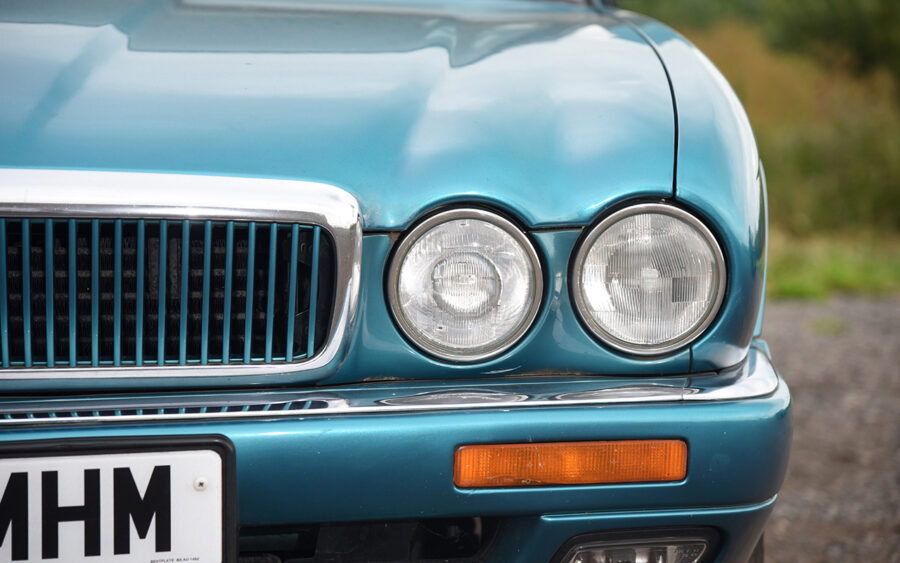
Jaguar XJ (X300): our verdict
Our extensive guide to the various foibles of the X300 XJ may put you off, but really there’s plenty to love about Jaguar’s retro-styled saloon. A good example will provide effortless pace and sumptuous comfort on a long journey, while a leggier car can represent a good rolling project given good parts and specialist support available.
It may not benefit from the later X308 model’s AJ-V8 but the X300 XJ benefits from fantastic traditional Jaguar powerplants; its possible that a good car will hold its value well given its combination of classic Jaguar traits and relative scarcity.

